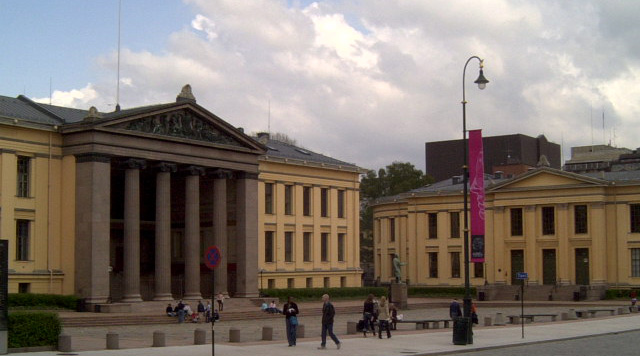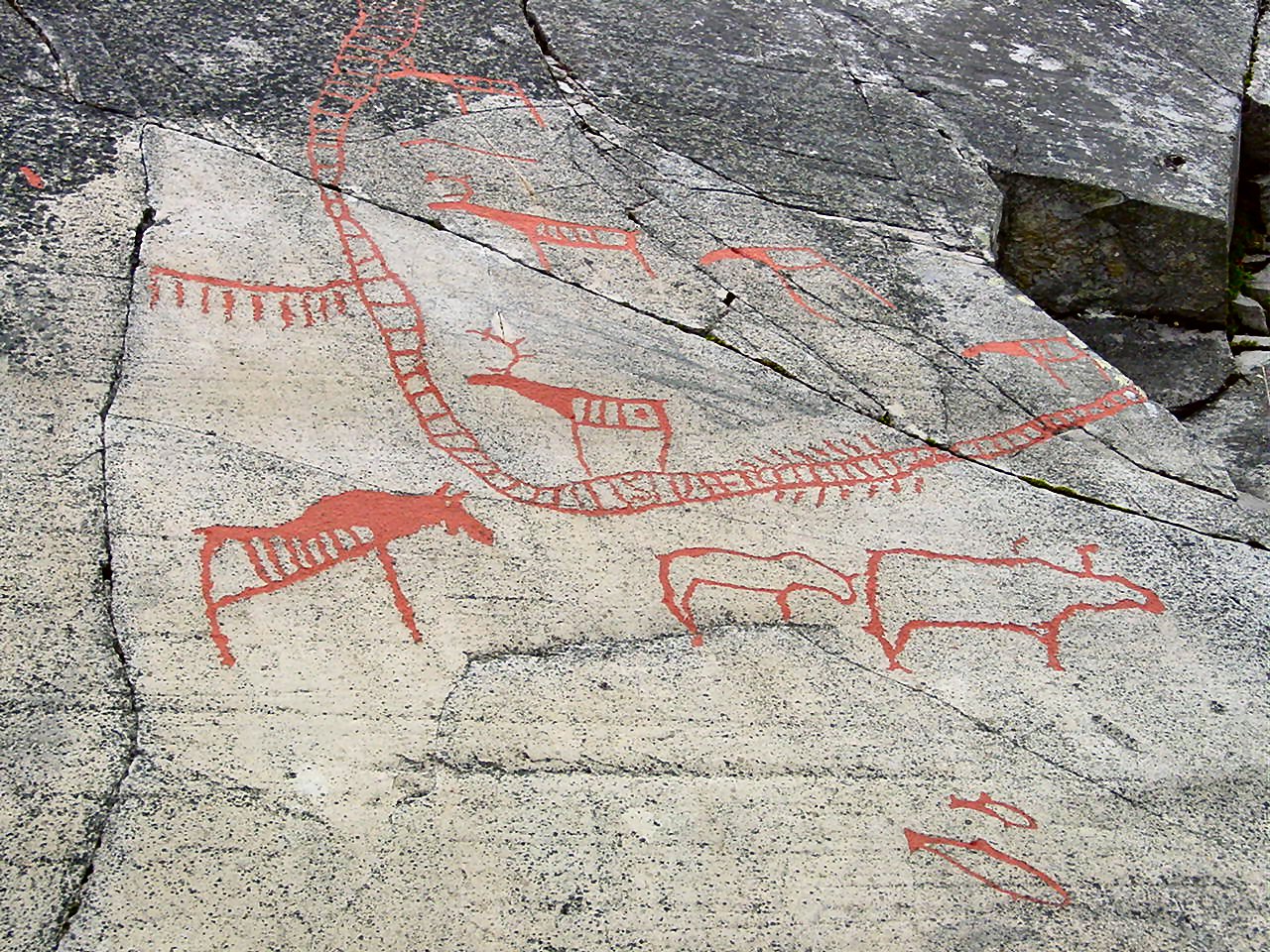|
Anatomigården
Anatomigården is a historic house located on the north side of Christiania Torv in Oslo, Norway. History Antanomigården is located at ''Christiania Torv'', in an area in Oslo's old city center known as ''Kvadraturen''. It is one of the few remaining houses in Oslo built with the timber framing method. It is in an area where about 50% of the buildings were half-timbered in the middle of 18th century. The facades (brick walls) of the building are sanded and covered with layers of protective rock materials, so the timbers are only visible on the gables. The age is unknown, but the house is likely to be from the 17th century. It is conserved, like the adjacent historic building, ''Rådmannsgården''. In the 1800s, the Faculty of Medicine of University of Oslo had its division of anatomy here - hence the name ''Anatomigården'' (meaning " Anatomy House"). The building served as a headquarters for this faculty until a new building was erected on the main University campus at Bli ... [...More Info...] [...Related Items...] OR: [Wikipedia] [Google] [Baidu] |
Oslo
Oslo ( , , or ; sma, Oslove) is the capital and most populous city of Norway. It constitutes both a county and a municipality. The municipality of Oslo had a population of in 2022, while the city's greater urban area had a population of in 2019, and the metropolitan area had an estimated population of in 2021. During the Viking Age the area was part of Viken. Oslo was founded as a city at the end of the Viking Age in 1040 under the name Ánslo, and established as a ''kaupstad'' or trading place in 1048 by Harald Hardrada. The city was elevated to a bishopric in 1070 and a capital under Haakon V of Norway around 1300. Personal unions with Denmark from 1397 to 1523 and again from 1536 to 1814 reduced its influence. After being destroyed by a fire in 1624, during the reign of King Christian IV, a new city was built closer to Akershus Fortress and named Christiania in honour of the king. It became a municipality (''formannskapsdistrikt'') on 1 January 1838. The city ... [...More Info...] [...Related Items...] OR: [Wikipedia] [Google] [Baidu] |
Norway
Norway, officially the Kingdom of Norway, is a Nordic country in Northern Europe, the mainland territory of which comprises the western and northernmost portion of the Scandinavian Peninsula. The remote Arctic island of Jan Mayen and the archipelago of Svalbard also form part of Norway. Bouvet Island, located in the Subantarctic, is a dependency of Norway; it also lays claims to the Antarctic territories of Peter I Island and Queen Maud Land. The capital and largest city in Norway is Oslo. Norway has a total area of and had a population of 5,425,270 in January 2022. The country shares a long eastern border with Sweden at a length of . It is bordered by Finland and Russia to the northeast and the Skagerrak strait to the south, on the other side of which are Denmark and the United Kingdom. Norway has an extensive coastline, facing the North Atlantic Ocean and the Barents Sea. The maritime influence dominates Norway's climate, with mild lowland temperatures on the ... [...More Info...] [...Related Items...] OR: [Wikipedia] [Google] [Baidu] |
Timber Framing
Timber framing (german: Holzfachwerk) and "post-and-beam" construction are traditional methods of building with heavy timbers, creating structures using squared-off and carefully fitted and joined timbers with joints secured by large wooden pegs. If the structural frame of load-bearing timber is left exposed on the exterior of the building it may be referred to as half-timbered, and in many cases the infill between timbers will be used for decorative effect. The country most known for this kind of architecture is Germany, where timber-framed houses are spread all over the country. The method comes from working directly from logs and trees rather than pre-cut dimensional lumber. Hewing this with broadaxes, adzes, and draw knives and using hand-powered braces and augers (brace and bit) and other woodworking tools, artisans or framers could gradually assemble a building. Since this building method has been used for thousands of years in many parts of the world, many st ... [...More Info...] [...Related Items...] OR: [Wikipedia] [Google] [Baidu] |
University Of Oslo
The University of Oslo ( no, Universitetet i Oslo; la, Universitas Osloensis) is a public research university located in Oslo, Norway. It is the highest ranked and oldest university in Norway. It is consistently ranked among the top universities in the world and as one of the leading universities of Northern Europe; the Academic Ranking of World Universities ranked it the 58th best university in the world and the third best in the Nordic countries. In 2016, the Times Higher Education World University Rankings listed the university at 63rd, making it the highest ranked Norwegian university. Originally named the Royal Frederick University, the university was established in 1811 as the de facto Norwegian continuation of Denmark-Norway's common university, the University of Copenhagen, with which it shares many traditions. It was named for King Frederick VI of Denmark and Norway, and received its current name in 1939. The university was commonly nicknamed "The Royal Freder ... [...More Info...] [...Related Items...] OR: [Wikipedia] [Google] [Baidu] |
Anatomy
Anatomy () is the branch of biology concerned with the study of the structure of organisms and their parts. Anatomy is a branch of natural science that deals with the structural organization of living things. It is an old science, having its beginnings in prehistoric times. Anatomy is inherently tied to developmental biology, embryology, comparative anatomy, evolutionary biology, and phylogeny, as these are the processes by which anatomy is generated, both over immediate and long-term timescales. Anatomy and physiology, which study the structure and function of organisms and their parts respectively, make a natural pair of related disciplines, and are often studied together. Human anatomy is one of the essential basic sciences that are applied in medicine. The discipline of anatomy is divided into macroscopic and microscopic. Macroscopic anatomy, or gross anatomy, is the examination of an animal's body parts using unaided eyesight. Gross anatomy also includes the br ... [...More Info...] [...Related Items...] OR: [Wikipedia] [Google] [Baidu] |
Blindern
Blindern is the main campus of the University of Oslo, located in Nordre Aker in Oslo, Norway. Campus Most of the departments of the University of Oslo are located at Blindern; other, smaller campuses include Sentrum (law), Gaustad (medicine), St. Hanshaugen (odontology) and Tøyen (botany, zoology, geology and paleontology). The central building is the new university library, Georg Sverdrup's house. Other buildings of note are Eilert Sundt's house, the social studies building; the humanities buildings, named after Sophus Bugge, Henrik Wergeland, Niels Treschow and P. A. Munch; Frederikke, the welfare building; and Niels Henrik Abel's house, for mathematical studies, the biology building, named after Kristine Bonnevie, the first female professor at Oslo University. Though the construction of a university campus at Blindern was decided on as early as 1921, the first buildings were not ready for use before 1931. Only in 1960 was Upper Blindern, the area most associate wi ... [...More Info...] [...Related Items...] OR: [Wikipedia] [Google] [Baidu] |
Brynjulf Bergslien
Brynjulf Larsen Bergslien (12 November 1830 – 19 September 1898) was a noted Norwegian sculptor. Background Bergslien was born in Voss in Hordaland county, Norway. He was a son of Lars Bergeson Bergslien and Kirsten Knutsdotter Gjelle. He was a brother of noted painter and master artist Knud Bergslien. In 1861 he married Johanne Christine Tønnesen (1842–1930). Career He studied under Jens Adolf Jerichau and Herman Wilhelm Bissen in Copenhagen between 1853 and 1861. In 1861 he settled in Kristiania (now Oslo) where he ran his own engraving workshop. Bergslien also operated an artist's training studio. Among his students were Sigvald Asbjornsen and Gustav Vigeland. He sculpted several prominently placed statues in Oslo, including that of King Charles John of Norway and Sweden (1875) at Slottsplassen in front of the Royal Palace. He was also noted for the statue of f Henrik Wergeland (1881) at Eidsvolls plass Eidsvolls plass ("Eidsvoll Square") is a square and park in ... [...More Info...] [...Related Items...] OR: [Wikipedia] [Google] [Baidu] |
History Of Norway
The history of Norway has been influenced to an extraordinary degree by the terrain and the climate of the region. About 10,000 BC, following the retreat inland of the great ice sheets, the earliest inhabitants migrated north into the territory which is now Norway. They traveled steadily northwards along the coastal areas, warmed by the Gulf Stream. They were hunter-gatherers whose diet included seafood and game, particularly reindeer as staple foods. Between 5,000 BC and 4,000 BC the earliest agricultural settlements appeared around the Oslofjord. Gradually, between 1500 BC and 500 BC, agricultural settlements spread to the entire south Norway, while the inhabitants of the regions north of Trøndelag continued to hunt and fish. The Neolithic period started in 4000 BC. The Migration Period caused the first chieftains to take control and hilltop forts to be constructed. From the 8th century Norwegians started expanding across the seas to the British Isles and later Iceland and G ... [...More Info...] [...Related Items...] OR: [Wikipedia] [Google] [Baidu] |






